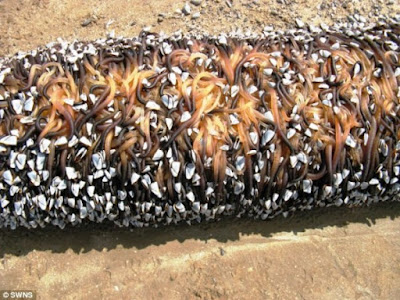In the days before it was realised that birds migrate, it was thought that barnacle geese,Branta leucopsis, developed from this crustacean, since they were never seen to nest in temperate Europe, hence the English names "goose barnacle", "barnacle goose" and the scientific name Lepas anserifera (Latin anser = "goose"). The confusion was prompted by the similarities in colour and shape. Because they were often found on driftwood, it was assumed that the barnacles were attached to branches before they fell in the water. TheWelsh monk, Giraldus Cambrensis, made this claim in his Topographia Hiberniae.
Since barnacle geese were thought to be "neither flesh, nor born of flesh", they were allowed to be eaten on days when eating meat was forbidden by Christianity ,though it was not universally accepted. The Holy Roman Emperor Frederick II examined barnacles and noted no evidence of any bird-like embryo in them, and the secretary of Leo of Rozmital wrote a very skeptical account of his reaction to being served the goose at a fast-day dinner in 1456.


No comments:
Post a Comment